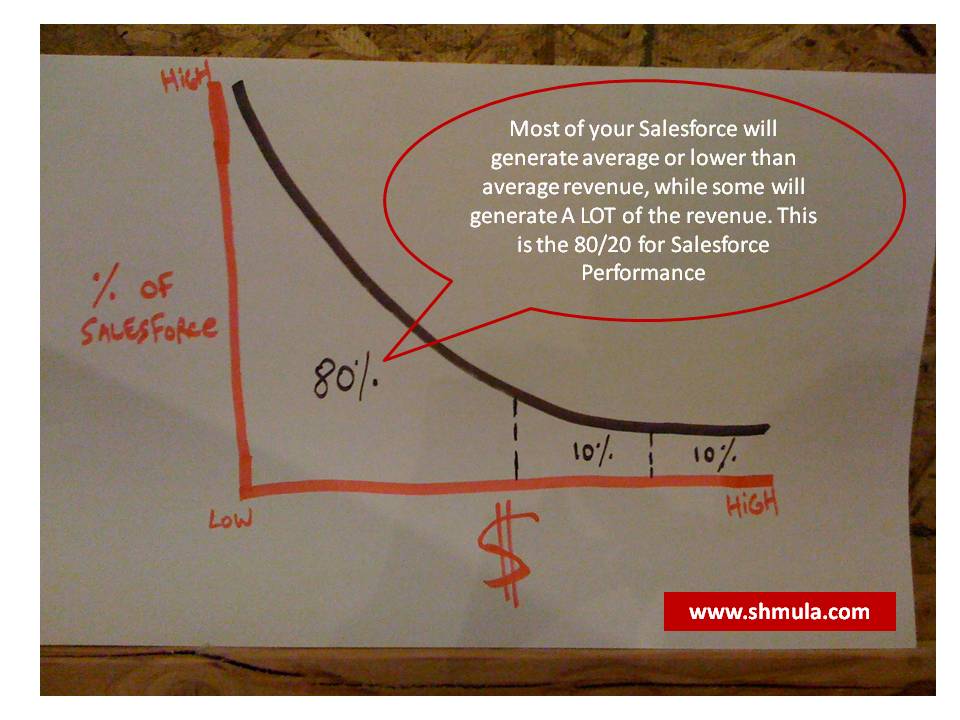The Pareto Principle ( the 80/20 principle) can be seen in many, many situations. I was reminded of this fact recently when a friend and I discussed a sales force effectiveness question he had.
[contentblock id=33]
My friend is in the pharmaceutical industry (pharma) and most pharmaceutical firms have a very large sales force, with geographical territories, targeting physicians and doctors that specialize in the diseases for which the pharmaceutical representative’s drug supposedly treats.
For example, if one is selling a diabetes drug, then the pharmaceutical rep might target primary care physicians, physicians that specialize in cardiovascular health, or ophthalmologist. Why? A co-morbidity of diabetes are heart problems and diabetic retinopathy, or blindness from diabetes.
You get the point.
In our discussion, he explained that a few of his sales force generates the bulk of the drug sales. During our discussion, I drew a picture of what he described with words:
 In other words, the majority of your sales force will generate average to below average sales, while roughly 20% of your sales force will generate 80% of the drug sales.
In other words, the majority of your sales force will generate average to below average sales, while roughly 20% of your sales force will generate 80% of the drug sales.
The anecdotal data he shared with me really validates the Pareto Principle. In fact, for my friend, about 13 sales reps are responsible for roughly 67% of the drug sales in his territory. Indeed, sales force performance is defined by those sales reps.
But this is just the beginning. One can actually use this model and framework to increase the performance of their sales force, or increasing sales force effectiveness.
Sales Force Effectiveness Model
Once you’ve identified the top 20% of your sales force that is generating the majority of your sales, consider the following questions:
- What are they doing differently than the rest? Look out for small, subtle behaviors or practices or habits. Something small can make a big difference.
- Related to #1, consider positive variance. Are your sales reps that generate the majority of the sales doing something unique?
These questions, while seemingly simple, are the beginning to improving the effectiveness of your sales force.








As someone who worked in sales force strategy and deployment planning with the pharmaceutical industry, the pareto rule does not apply to territory design. Territories are typically designed to be balanced in potential and workload, so imbalances like your friend is seeing is rare. Think about the equity issues on the team when someone has a lot more potential than the next territory. Looking for best practices among the top reps can help, but if there are big swings in value, then you should be balancing the load better.
Hi Chris – thanks much for your feedback on territory design for sales reps. Given your comment, can you share with us the key factors to consider in case my friend’s company decides to redesign their sales territories?
The advise your provided to your friend is inaccurate and misleading.
In order to draw inferences about the sales reps , you need to understand the system of variation that contains the sales rep. population. If assignable causes exist, then you need to investigate them.
You assume that individual’s performance is the dominant source of variation, i.e. “subtle behaviors or practices”, etc. You are not considering the system where these reps operate, the nature of the process by which territories are assigned, the nature of their sales territory, the sales management process, constrains imposed by their own organization, etc. You may also consider the information provided by Chris P in the previous post.
Fernando,
Thanks for your comment. I don’t have much experience in sales territory management, so I appreciate your feedback.
Pete